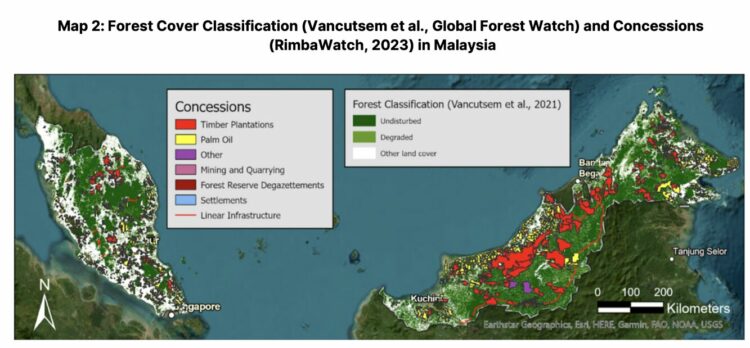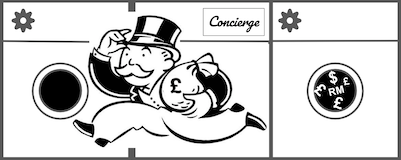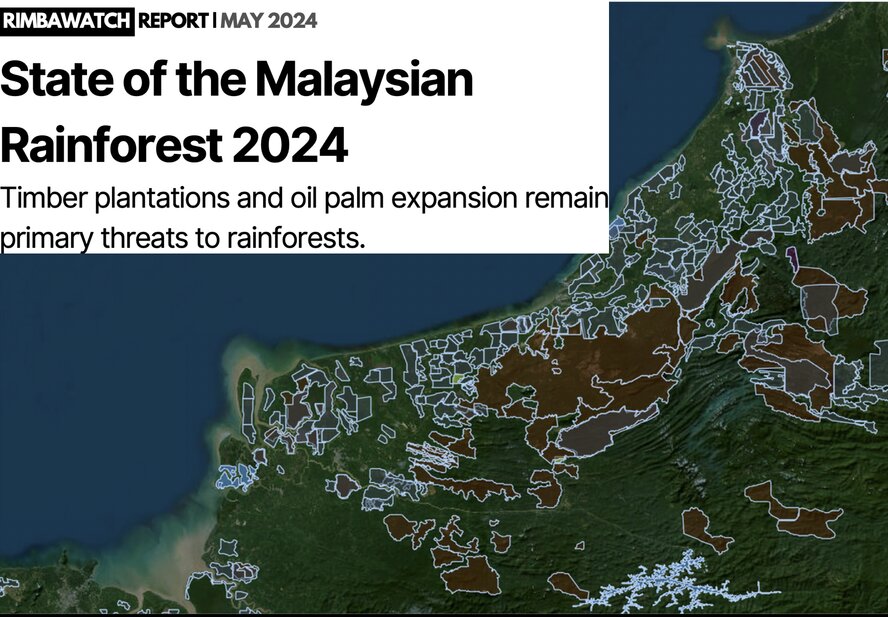According to the latest report by the Malaysian environmental group RimbaWatch, the vast majority of remaining rainforest under grave threat from timber concessions is based in Sarawak – where the ruling party are pushing harder than ever for autonomy to pursue their cash ambitions.
The report released last week identifies that of 3.2 million hectares of forest threatened with obliteration in the country 2.3m hectares lie in Sarawak.
The total area concessioned to the timber tycoons for further industrial timber plantations (ITP) in the state is 1.7m, with a further 596,000 hectares handed out for oil palm. There is an oil palm and ITP overlap of 441,000 hectares according to the NGO’s analysis of open source information across Malaysia.
The sheer enormity of these figures throws into perspective recent sanctimonious efforts to convert a relatively minuscule portion of these areas into so-called carbon credit schemes – usually where industrial plantations have proven difficult to implement.
The controversial SaraCarbon project, initiated by Samling, relates to a mere 39,000 of the million and a half hectares which have been signed over to the Yaw family by the state government.
Under Sarawak’s ‘autonomous’ legislation a derisory state royalty of 5% has been allocated for such conversion projects, which have moreover involved extending the tycoons’ existing plantation licences for several decades for no discernible public benefit.
As with the various timber and plantation licences handed out to the same handful of crony companies in the past, the level of consultation with local communities has been heavily criticised with numerous violations reported in the process.
RimbaWatch calculates that nearly 250,000 hectares of concessions, mostly timber plantations, encroach on customary land boundaries.
However, the NGO points out, this destruction continues to be under-reported by the Malaysian authorities themselves thanks to lack of transparency of data and loopholes in definitions.
Indeed, from the available data RimbaWatch has calculated that Malaysia is already headed towards a violation of its international and domestic committments to maintain 50% of its land cover as forest, a commitment which is enshrined in a number of national policies.
Instead, it has dipped already to 46-47% and, according to the different measures available, could drop to 40% if all the current concessions are fully exploited.

The study has evaluated comparative data and concluded the biggest threat to the forest cover are timber plantations, also the selective logging of critical dipterocarp trees which is largely ignored by the official figures. The Gaveau dataset includes areas damaged in this way:
In all three baselines [used in the calculations], Malaysia’s forest cover will drop below 50%. While Malaysia’s forest coverage under the Vancutsem et al. dataset is 5% higher than officially reported figures, the clearance of remaining forests in known concessions will still result in an eventual forest cover which falls below 50%, particularly when taking into account that the concession data presented here is not comprehensive due to non-transparency of data. Conversely, the Gaveau dataset proposes that Malaysia’s forest cover has already dropped below 50%…… we make the recommendation that the Gaveau dataset best represents Malaysia’s forest cover as it excludes heavily logged forests and non-natural forests.
“Oil palm plantations no longer top driver of deforestation in Malaysia”
The report also points out that “the official position of the Peninsular Malaysia, Sarawak and Sabah authorities is that timber plantations are a method of rehabilitating degraded forests which reduces pressure on natural forests.
“These authorities refer to timber plantations as ‘Forest Plantations’, ‘Planted Forests’ and ‘Forest Farms’ respectively, which in reality are monoculture plantations of rubberwood, acacia and other species in forest reserve land.”
Such monocultures are, of course, no better for the environment, nor indeed for carbon capture, than palm oil plantations which Malaysia has pledged to bring under control in order to meet its stated commitment to achieve 100% MSPO certification, which would expose plantations to a cut-off date of 31st December 2019.
Thus, while oil palm is being reined in it is being replaced by other unsuitable, quick grow, intensive crops that destroy the landbank, kill off diversity and belch out shocking quantities of carbon during the process of planting and harvesting:
“in the case of timber plantations alone, 368,615,839.92 MgC [Carbon] is expected to be released from the conversion of known concessions, which is roughly equal to the overall emissions of Petronas in 2022“
Loopholes and Malaysia’s Shocking ‘Greenwash’ Con
Timber plantations are exclusively located in areas gazetted in Peninsular Malaysia as Permanent Forest Reserves, in Sarawak as Permanent Forest Estates and in Sabah as Forest Reserves. As the land-use is not changed on paper when a natural forest in a gazetted estate or reserve is converted to monoculture, Malaysia does not consider any clearances for timber plantations as deforestation, regardless of physical changes to the ecosystem.
Therefore, the 1,464,078.61 ha to 2,128,616.58 ha of degraded and undisturbed forests identified as under threat from conversion in the two baselines will not be recorded by Malaysia as deforestation; which is an inaccuracy calls into question the legitimacy of Malaysia’s biodiversity and climate reporting mechanisms, and the possibility of Malaysia ‘greenwashing’ it’s deforestation due to this loophole.”
In short, this “inaccuracy” represents a shocking con by which Malaysia is seeking to represent intensive agro-forestry as being somehow of equivalent value to genuine forest cover in terms of bio-diversity and carbon capture.
That is certainly Greenwash and it is time the international community called Malaysia out and to demand full data transparency as it makes its reports to international frameworks:
“Maps of timber plantation concessions are grossly outdated and have not been updated to take into account new areas zoned for plantations… Further, maps are not commonly available on Forestry Department websites.
The link to the map of License for Planted Forest Concessions from the Sarawak Forestry Department’s website became inaccessible after the publication of the SMR 2023. The Ministry of Natural Resources, Environment and Climate Change has not yet delivered on promises to share EIA reports, which remain unavailable. There is still no publicly available list of EIAs for Sarawak. Further, the Malaysian Palm Oil Certification Council (MPOCC) stated that they would publish maps of oil palm concessions in Malaysia in 2019, but has yet to follow up on this.
Transparency is needed throughout. Without comprehensive open data from all Malaysia’s reporting agencies (including Sarawak’s Forestry Department) all the claimed statistics on ‘Forest Cover’ must be treated as little more than Greenwash deception by the international community as the race to claim carbon credits gets underway.

